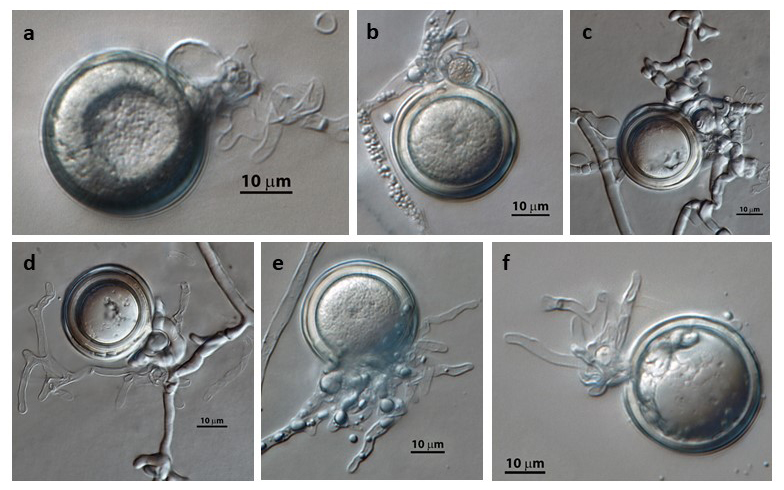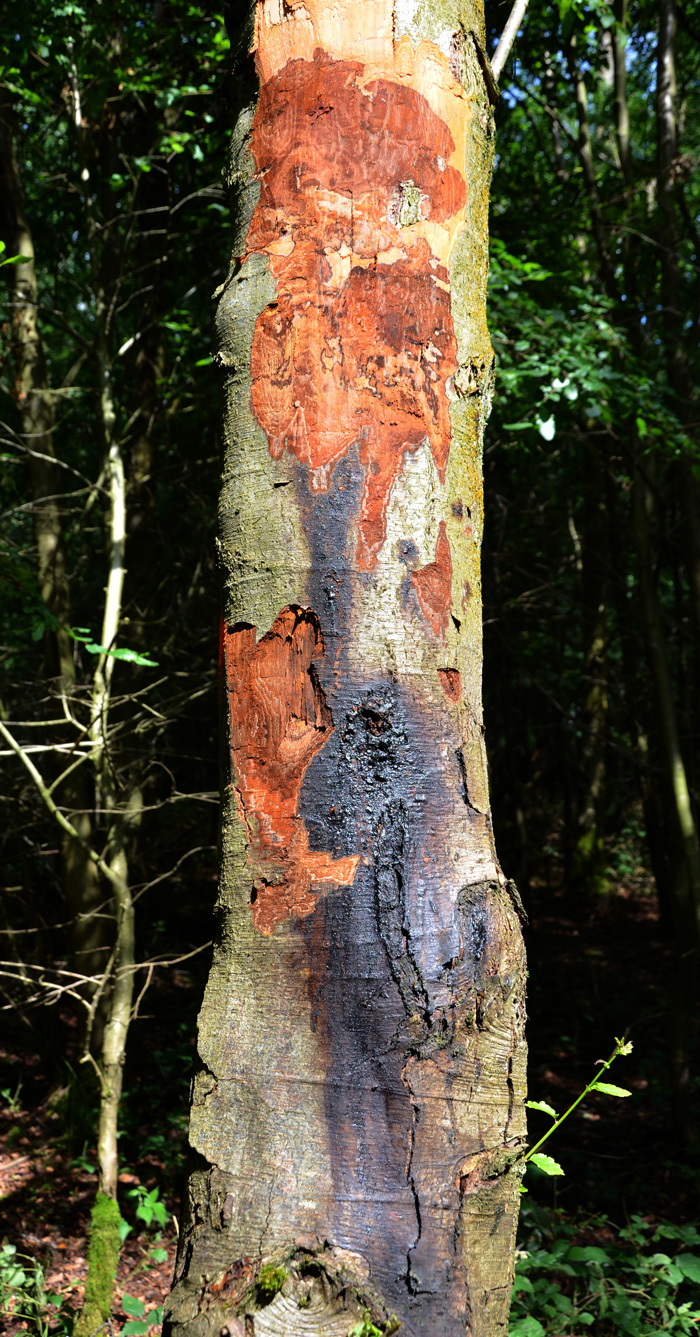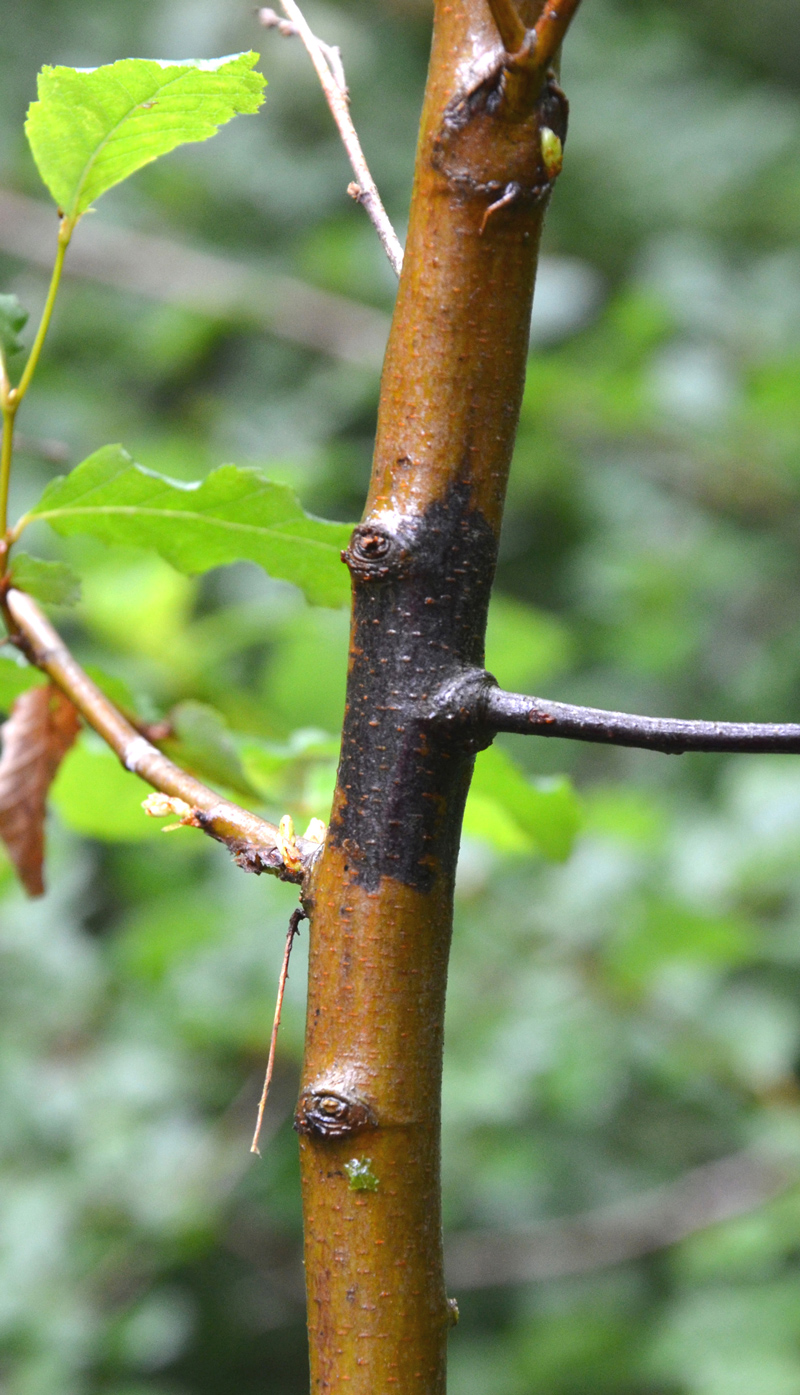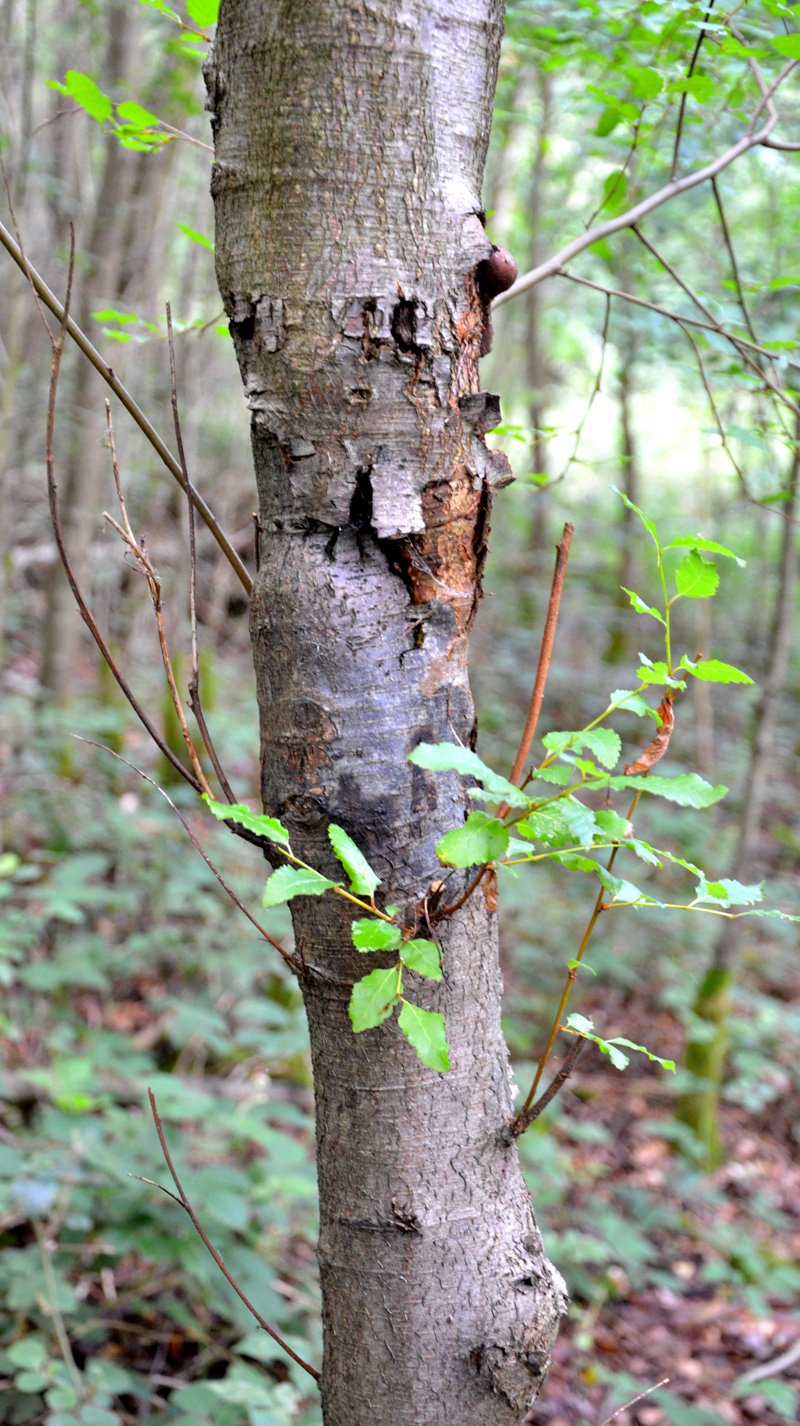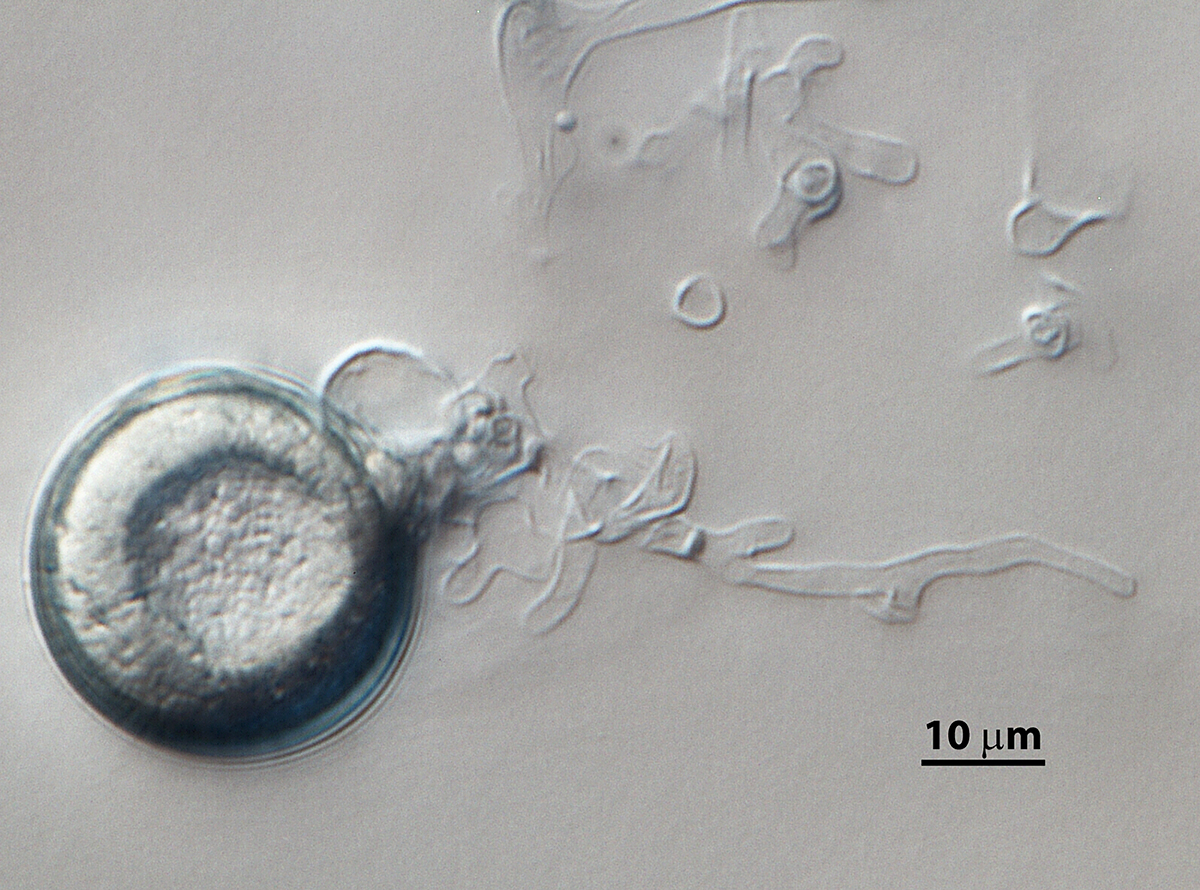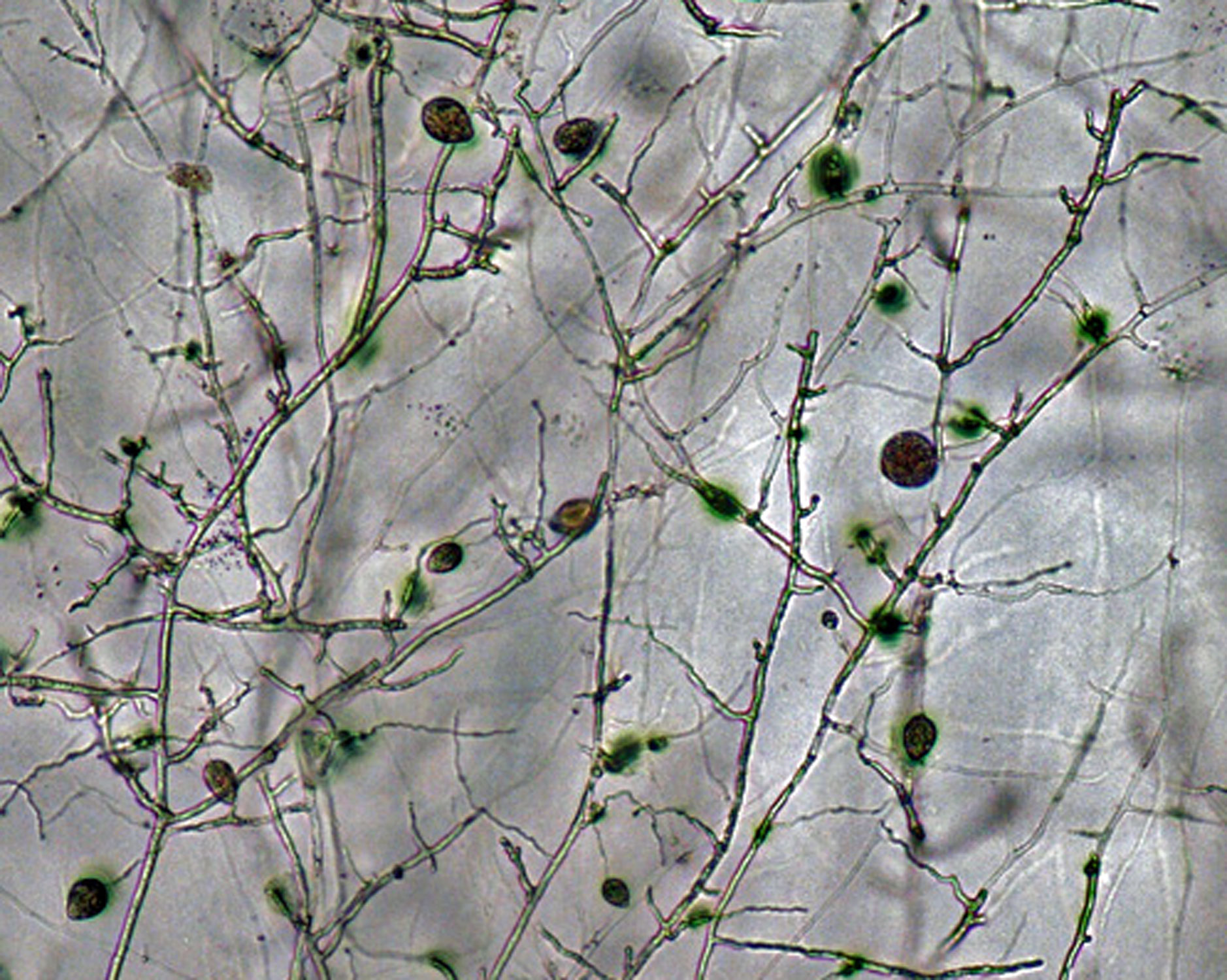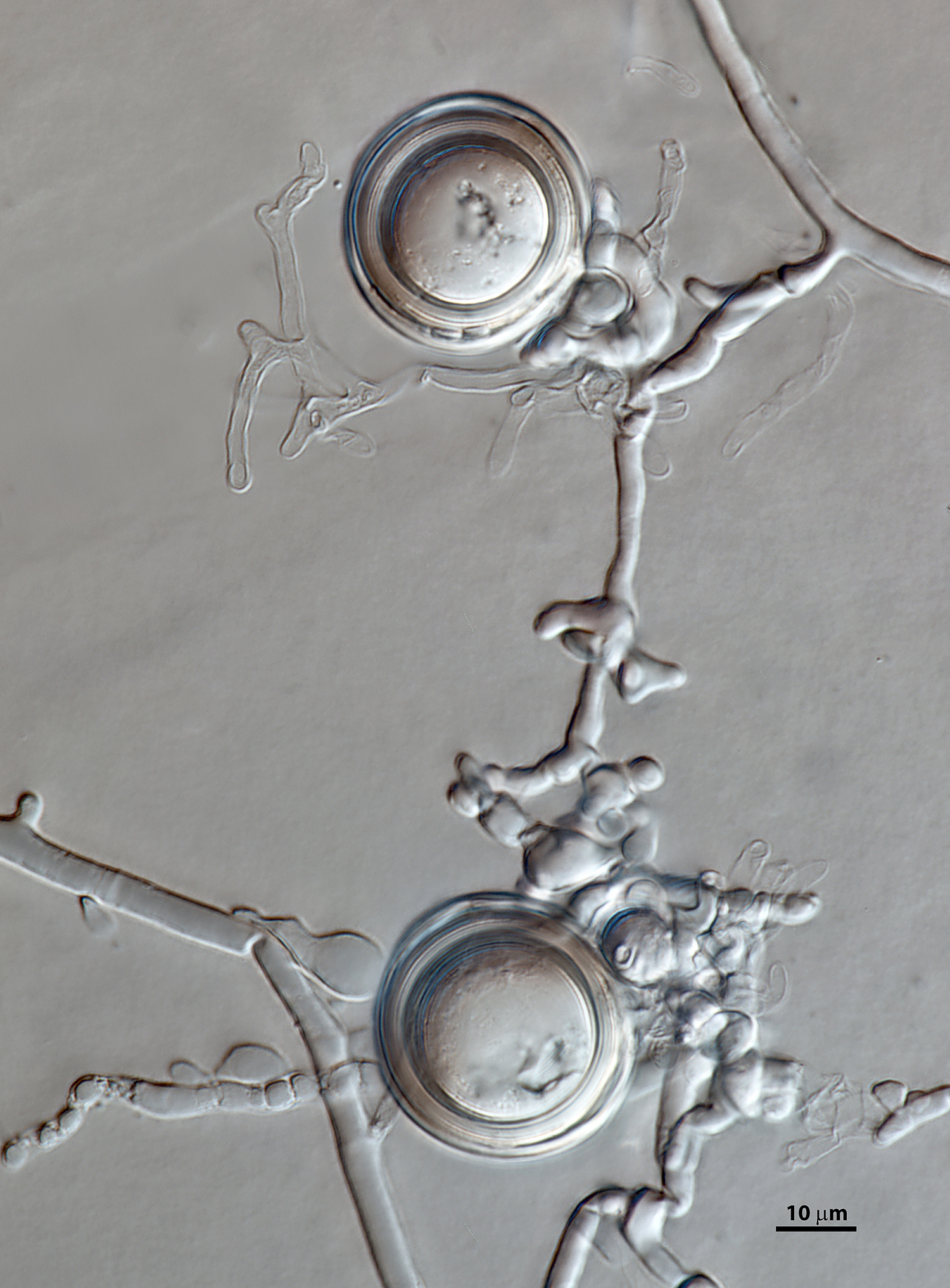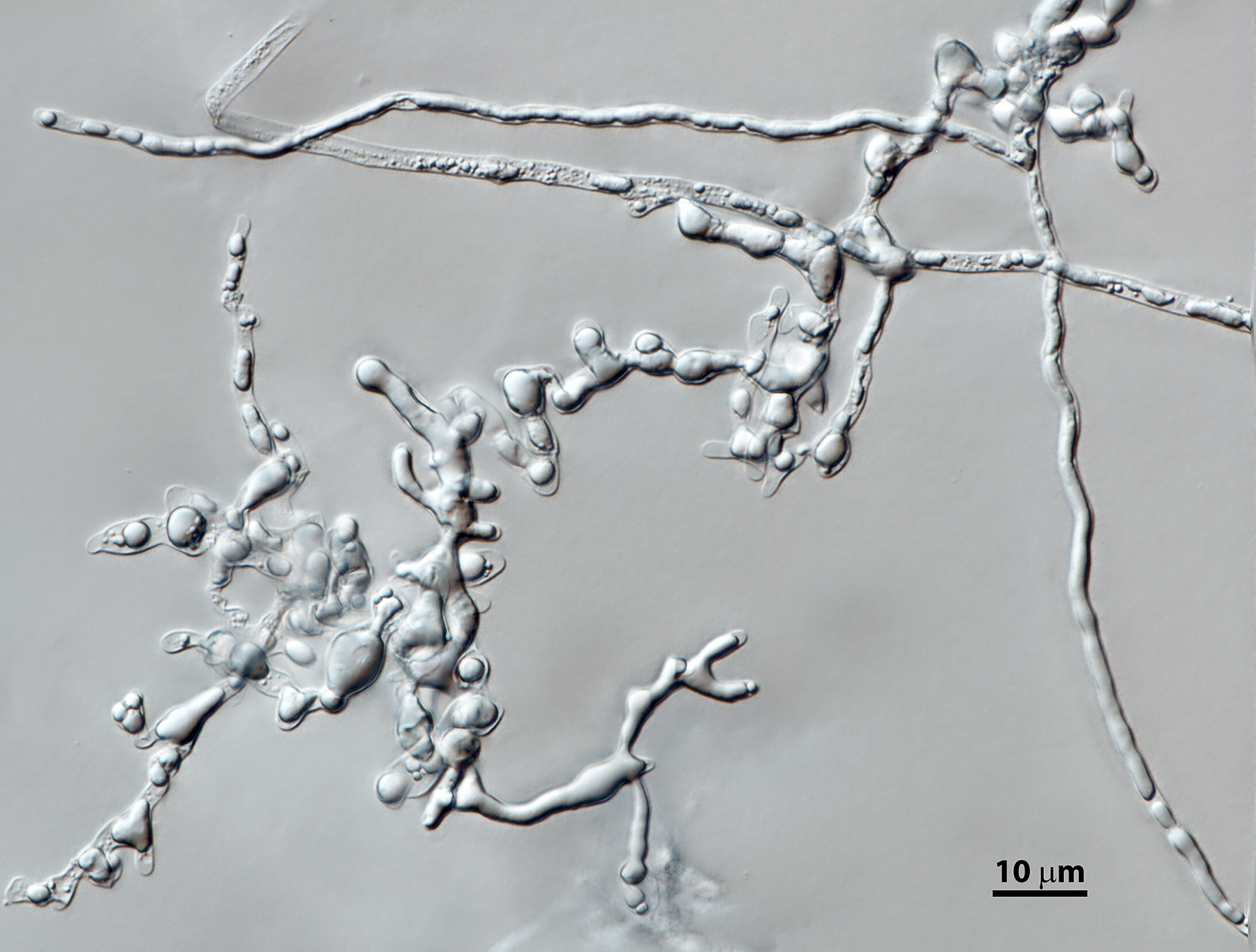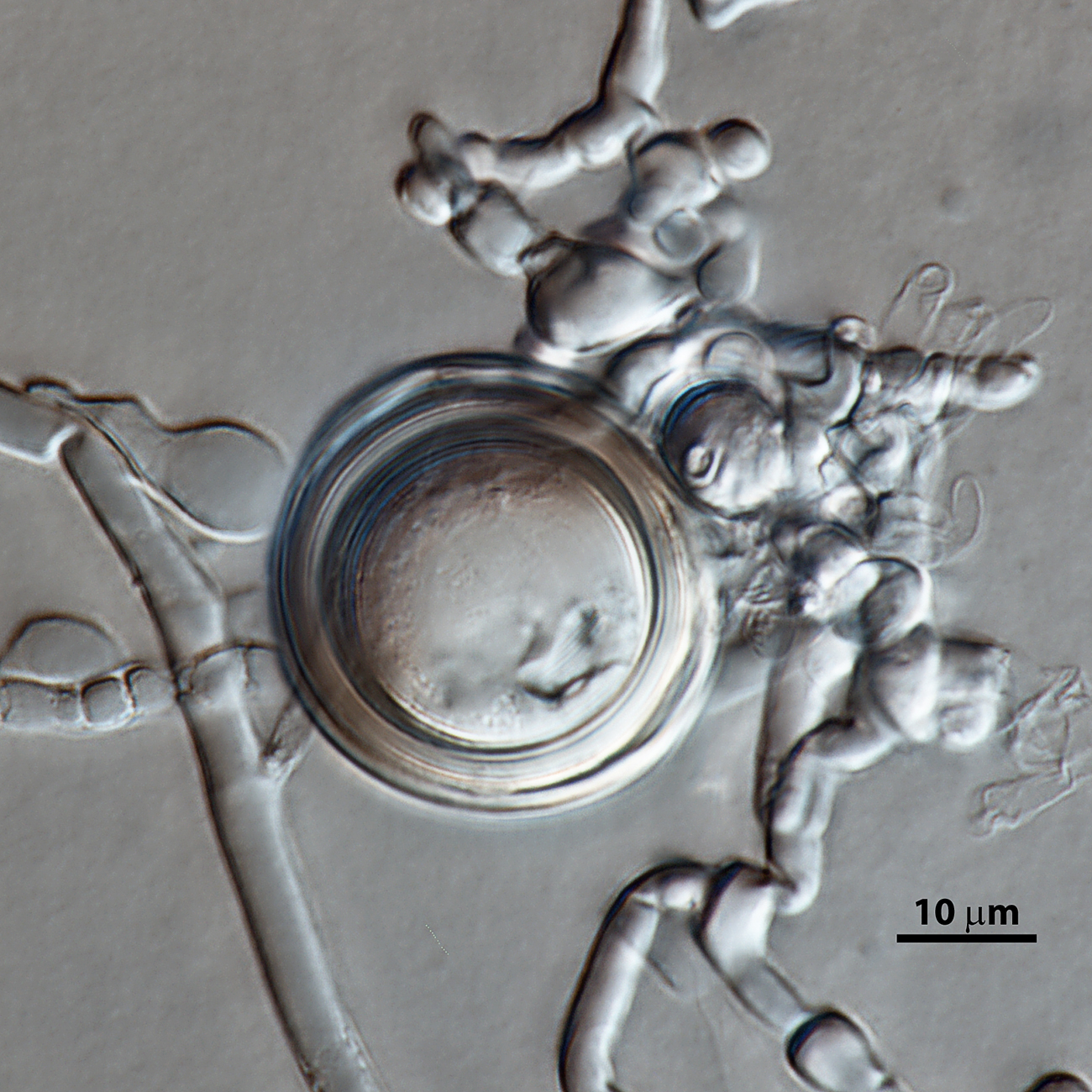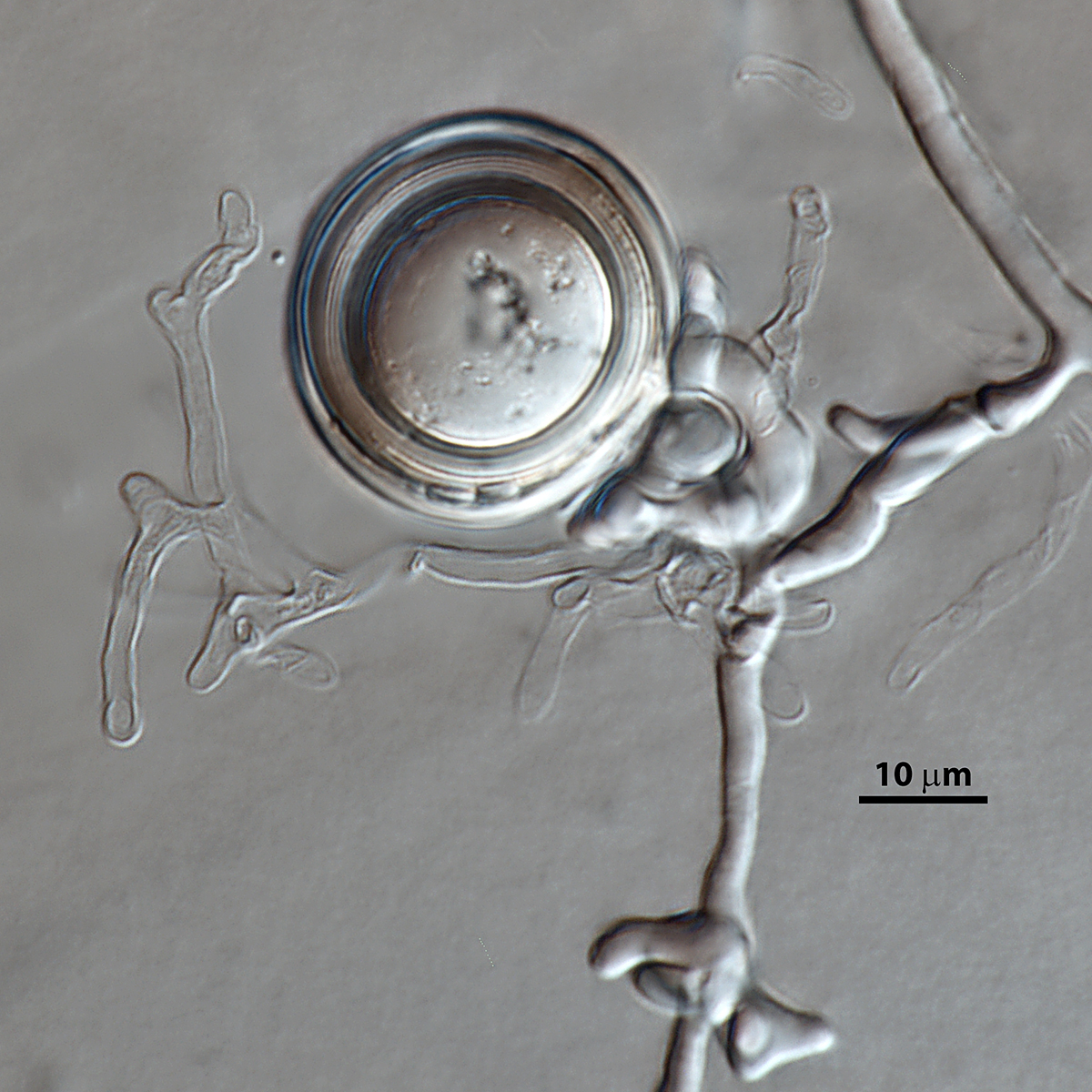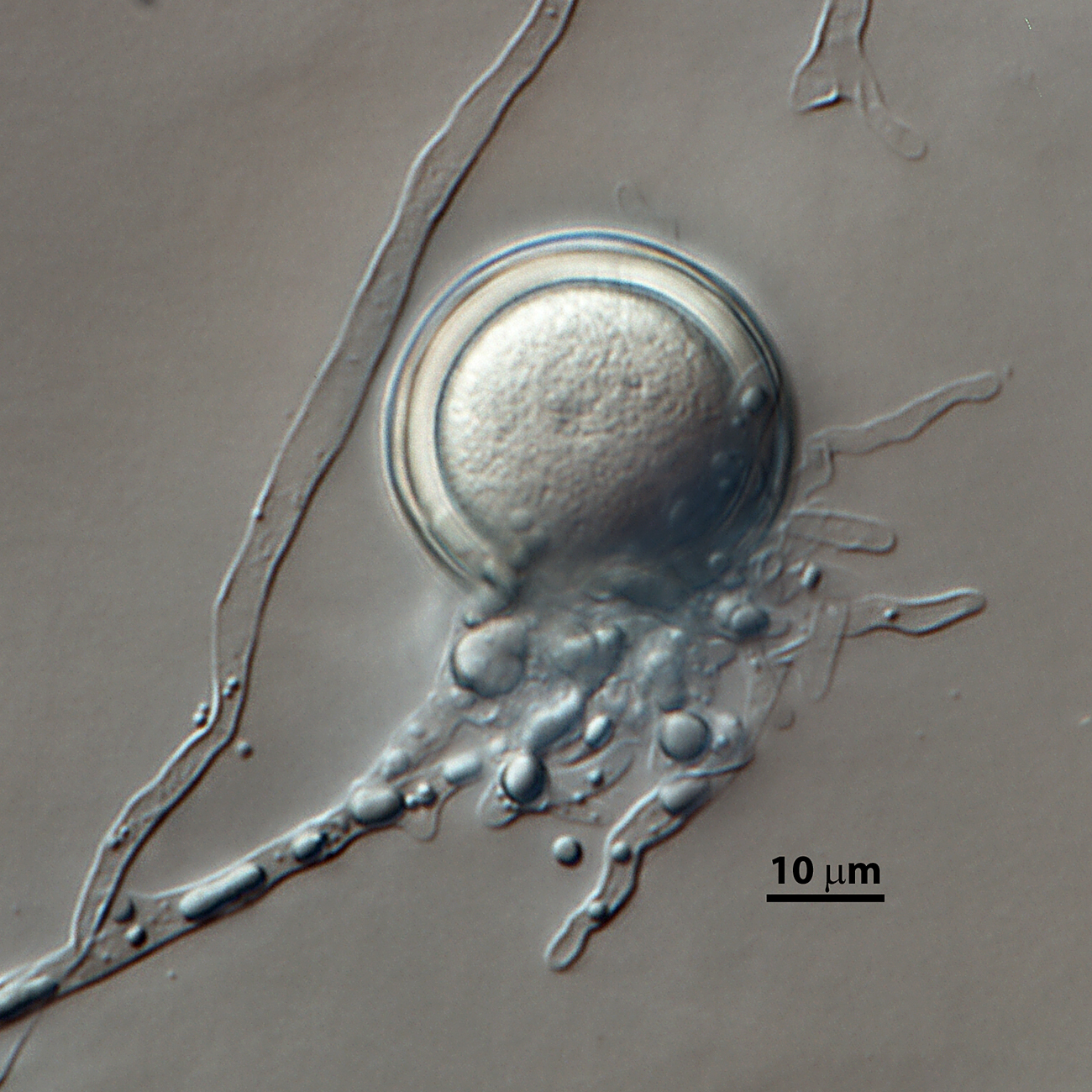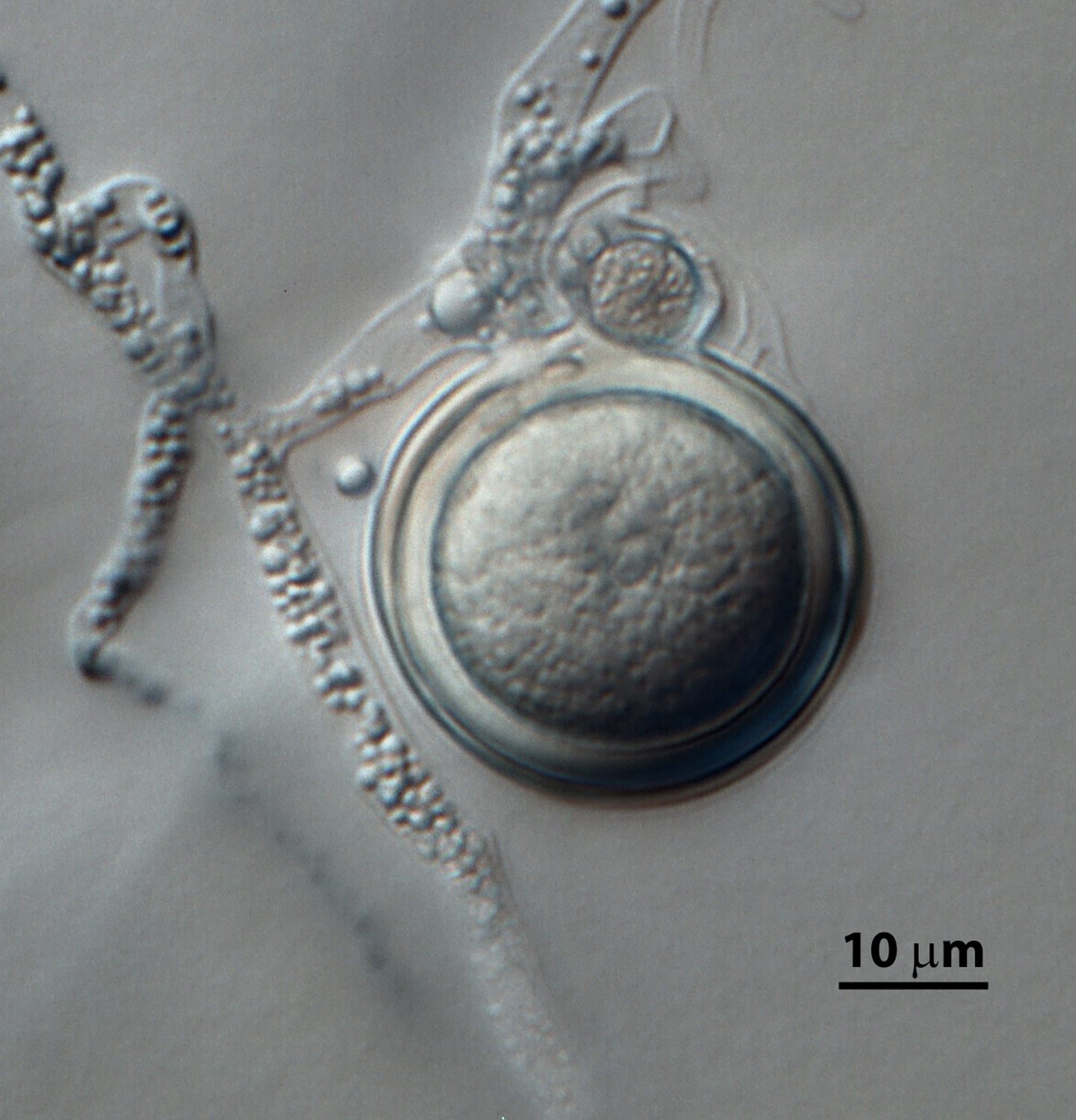Phytophthora pseudosyringae
|
Phytophthora spp. in Clade 3: portion of the seven-loci ML phylogeny featuring the type cultures of 212 described species (by T. Bourret). Notice the position of P. pseudosyringae Ex-type CBS 111772 = S&T BL 51G. Gloria Abad, USDA S&T.
|
|
Phytophthora spp. in Clade 3: Morphological Tabular key (PDF) and Tabular key legends (PDF) in IDphy2 KEY SECTION. Notice the data of P. pseudosyringae Ex-type CBS 111772 = S&T BL 51G. Gloria Abad, USDA S&T.
|
|
Phytophthora pseudosyringae (CPHST BL 51G) colonies of the ex-type grown for 7 days on (a) V8® Agar, (b) potato dextrose agar, and (c) malt extract agar; photo by Krysta Jennings and Leandra Knight, USDA-APHIS-PPQ |
|
Phytophthora pseudosyringae (ex-type CPHST BL 51G) asexual phase: (a) sporangia in sporangiophores, (b) coralloid mycelia; photos by Gloria Abad, USDA-APHIS-PPQ. |
|
Phytophthora pseudosyringae (ex-type CPHST BL 51G) sexual phase: gametangia with plerotic or slightly aplerotic oospores (a–f), paragynous antheridia (a, b), and with knotted hyphae (c–f); photos by Vickie Brewster, USDA-APHIS-PPQ. |
|
Large group of dead and dying mature trees of Nothofagus obliqua in Britain caused by Phytophthora pseudosyringae; photo by Bruno Scanu and Joan Webber, Forest Research, Alice Holt, Farnham, UK. |
|
Thinning, wilting and dieback of the entire crown on Nothofagus obliqua in Britain caused by Phytophthora pseudosyringae; photo by Bruno Scanu and Joan Webber, Forest Research, Alice Holt, Farnham, UK |
|
Extensive aerial bleeding lesion on the main stem of a Nothofagus obliqua tree in Britain caused by Phytophthora pseudosyringae; photo by Bruno Scanu and Joan Webber, Forest Research, Alice Holt, Farnham, UK
|
|
Necrotic and sunken lesion on twig of Nothofagus obliqua in Britain caused by Phytophthora pseudosyringae; photo by Bruno Scanu and Joan Webber, Forest Research, Farnham, Alice Holt, UK |
|
Bark canker with epicormic shoots on Nothofagus obliqua in Britain caused by Phytophthora pseudosyringae; photo by Bruno Scanu and Joan Webber, Forest Research, Farnham, Alice Holt, UK |
|
Phytophthora pseudosyringae (ex-type CPHST BL 51G) sexual phase: slightly aplerotic oospore with paragynous antheridium; photo by Vickie Brewster, USDA-APHIS-PPQ. |
|
Phytophthora pseudosyringae (ex-type CPHST BL 51G) asexual phase: sporangia in sporangiophores; photo by Gloria Abad, USDA-APHIS-PPQ. |
|
Phytophthora pseudosyringae (ex-type CPHST BL 51G) sexual phase: slightly aplerotic oospores with paragynous antheridium and knotted hyphae; photo by Vickie Brewster, USDA-APHIS-PPQ. |
|
Phytophthora pseudosyringae (ex-type CPHST BL 51G) asexual phase: coralloid mycelia; photo by Gloria Abad, USDA-APHIS-PPQ. |
|
Phytophthora pseudosyringae (ex-type CPHST BL 51G) sexual phase: slightly aplerotic oospore with paragynous antheridium and knotted hyphae; photo by Vickie Brewster, USDA-APHIS-PPQ. |
|
Phytophthora pseudosyringae (ex-type CPHST BL 51G) sexual phase: slightly aplerotic oospore with paragynous antheridium and knotted hyphae; photo by Vickie Brewster, USDA-APHIS-PPQ. |
|
Phytophthora pseudosyringae (ex-type CPHST BL 51G) sexual phase: slightly aplerotic oospore with paragynous antheridium and knotted hyphae; photo by Vickie Brewster, USDA-APHIS-PPQ. |
|
Phytophthora pseudosyringae (ex-type CPHST BL 51G) sexual phase: slightly aplerotic oospore with paragynous antheridium and knotted hyphae; photo by Vickie Brewster, USDA-APHIS-PPQ. |
Name and publication
Phytophthora pseudosyringae T. Jung & Delatour (2003)
Jung T, Nechwatal J, Cooke DE, Hartmann G, Blaschke M, Osswald WF, Duncan JM, and Delatour C. 2003. Phytophthora pseudosyringae sp. nov., a new species causing root and collar rot of deciduous tree species in Europe. Mycological Research 107: 772–789.
Correponding author: Jun@lwf.uni-muenchen.de
Nomenclature
from Jung et al. (2003)
Mycobank
Etymology
refers to morphological and physiological similarities to Phytophthora syringae that have led to misidentifications in the past
Typification
Type: GERMANY, isolated from rhizosphere of Quercus robur in Bavaria, Gerolzhofen, during November 1997 by T. Jung, IFB-GeroR7
Ex-type: CBS 111772 and IFB-PSEU 6 (living cultures)
Sequences for ex-type in original manuscript: ITSrDNA: AY230190 (PSEU 6)
Ex-type in other collections
(ET) CBS 111772, NRRL 64157, IFB-PSEU 6, WPC P10437, TJ1528, S&T BL 51G (Abad), 30A8 (Hong), p284 (Gallegly)
Molecular identification
Voucher sequences for barcoding genes (ITS rDNA and COI) of the ex-type (see Molecular protocols page)
Phytophthora pseudosyringae isolate CPHST BL 51G (= P10437 WPC) = ITS rDNA MG865574, COI MH136966
Voucher sequences for Molecular Toolbox with seven genes (ITS, β-tub, COI, EF1α, HSP90, L10, and YPT1
(see Molecular protocols page) (In Progress)
Voucher sequences for Metabarcoding High-throughput Sequencing (HTS) Technologies [Molecular Operational Taxonomic Unit (MOTU)]
(see Molecular protocols page) (In Progress)
Sequences with multiple genes for ex-type in other sources
- NCBI: Phytophthora pseudosyringae CPHST BL 51G
- NCBI: Phytophthora pseudosyringae P10437
- NCBI: Phytophthora pseudosyringae CBS 111772
- EPPO-Q bank: Phytophthora pseudosyringae CBS 111772
- BOLDSYSTEMS: Phytophthora pseudosyringae (barcoding COI & ITS)
Position in multigenic phylogeny with 7 genes (ITS, β-tub, COI, EF1α, HSP90, L10, and YPT1)
Clade clade:
a taxonomic group of organisms classified together on the basis of homologous features traced to a common ancestor
3
Morphological identification
adapted from Jung et al. (2003)
Colonies and cardinal temperatures
Colony colony:
assemblage of hyphae which usually develops form a single source and grows in a coordinated way
morphology on PDA, V8A, MEA with rosette chrysanthemum pattern. Minimum growth temperature 5°C, optimum 20°C, and maximum 25°C.
Conditions for growth and sporulation
Hyphal swellings formed in soil water extract. OogoniaOogonia:
the female gametangium in which the oospore forms after fertilization by the antheridium
readily produced in culture media.
Asexual phase
SporangiaSporangia:
sac within which zoospores form, especially when water is cooled to about 10°C below ambient temperature; in solid substrates, sporangia usually germinate by germ tubes
semipapillatesemipapillate:
pertaining to the production of shallow having papilla that are not well developed, shallow and less nipple-like than fully papillate structures
; persistentpersistent:
pertaining to sporangia that remain attached to the sporangiophore and do not separate or detach easily (cf. caducous)
but sometimes caducouscaducous:
pertaining to sporangia that become dislodged readily (i.e. deciduous) and separate from the sporangiophore (cf. persistent)
with short and medium pedicels (2–20 µm); limoniform, ellipsoidellipsoid:
refers to a solid body that forms an ellipse in the longitudinal plane and a circle in cross section; many fungal spores are ellipsoidal or elliptic
, ovoidovoid:
egg-shaped, with the widest part at the base of the sporangium and the narrow part at the apex
, obpyriformobpyriform:
inversely pear-shaped, i.e. with the widest part at the point of attachment (cf. pyriform)
, or irregular shapes (20–95 L x 18–45 W µm) and sometimes with elongated necks and with constrictions; no internal proliferationinternal proliferation:
internal proliferation occurs when the sporangiophore continues to grow through an empty sporangium
is observed, sporangiasporangia:
sac within which zoospores form, especially when water is cooled to about 10°C below ambient temperature; in solid substrates, sporangia usually germinate by germ tubes
originated individual or in simple sympodial and clustered sporangiophores. Hyphal swellings globoseglobose:
having a rounded form resembling that of a sphere
, subglobose, elongate formed in catenulated arrangement. ChlamydosporesChlamydospores:
an asexual spore with a thickened inner wall that is delimited from the mycelium by a septum; may be terminal or intercalary, and survives for long periods in soil
absent.
Sexual phase
Homothallichomothallic:
pertaining to sexual reproduction that can take place within a single thallus (i.e. self-fertile, non-outcrossing) (cf. heterothallic).
. OogoniaOogonia:
the female gametangium in which the oospore forms after fertilization by the antheridium
smooth-walled; spherical to slightly globoseglobose:
having a rounded form resembling that of a sphere
(20–37 µm diam) sometimes with tapered bases; antheridiaantheridia:
the male gametangium; a multinucleate, swollen hyphal tip affixed firmly to the wall of the female gametangium (the oogonium)
paragynousparagynous:
pertaining to the sexual stage in which the antheridium is attached to the side of the oogonium (cf. amphigynous)
, spherical, club-shaped, or irregular shape, sometimes showing digitate projections and knotted hyphae; oosporesoospores:
zygote or thick-walled spore that forms within the oogonium after fertilization by the antheridium; may be long-lived
pleroticplerotic:
pertaining to an oospore that fills the oogonium (cf. aplerotic)
, apleroticaplerotic:
pertaining to a mature oospore that does not fill the oogonium; i.e. there is room left between the oospore wall and oogonium wall (cf. plerotic)
, and slightly apleroticaplerotic:
pertaining to a mature oospore that does not fill the oogonium; i.e. there is room left between the oospore wall and oogonium wall (cf. plerotic)
(17–31 µm diam).
Most typical characters
Phytophthora pseudosyringae is characterized by the presence of sporangiasporangia:
sac within which zoospores form, especially when water is cooled to about 10°C below ambient temperature; in solid substrates, sporangia usually germinate by germ tubes
semipapillatesemipapillate:
pertaining to the production of shallow having papilla that are not well developed, shallow and less nipple-like than fully papillate structures
, persistentpersistent:
pertaining to sporangia that remain attached to the sporangiophore and do not separate or detach easily (cf. caducous)
but sometimes caducouscaducous:
pertaining to sporangia that become dislodged readily (i.e. deciduous) and separate from the sporangiophore (cf. persistent)
with short and medium pedicels, and the shape of the hyphal swellings.
Additional specimen(s) evaluated
Phytophthora pseudosyringae ex-type CPHST BL 51G, duplicate of P10437 (World Phytophthora Collection)
Hosts and distribution
Distribution: Europe, North America, South America (Chile)
Substrate: soil, roots; also fruits when inoculated
Disease note: root and collar rot; a moderately aggressive pathogen of various Quercus spp. (Jung et al. 2003); also causing a fruit rot of apple and leaf rot of Ilex aquifolium when inoculated
Host: Quercus spp., Fagus sylvatica, Alnus glutinosa, and other hardwood species
Retrieved February 01, 2018 from U.S. National Fungus Collections Nomenclature Database.
Additional references and links
- SMML USDA-ARS: Phytophthora pseudosyringae
- EPPO Global Database: Phytophthora pseudosyringae
- Forest Phytophthoras of the world: Phytophthora pseudosyringae
- CABI Digital Library: Phytophthora pseudorosyringae
- Encyclopedia of Life (EOL): Phytophthora pseudosyringae
- Index Fungorum (IF): Phytophthora pseudosyringae
- Google All Phytophthora pseudosyringae
- Google Images Phytophthora pseudosyringae
- Google Scholar Phytophthora pseudosyringae
Fact sheet author
Z. Gloria Abad, Ph.D., USDA-APHIS-PPQ-S&T Plant Pathogen Confirmatory Diagnostics Laboratory (PPCDL), United States of America.



